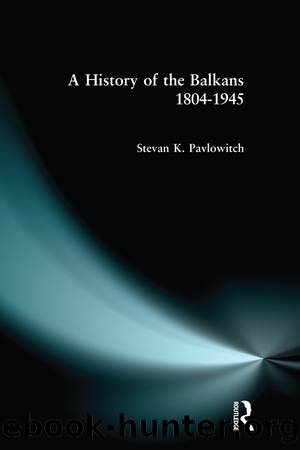A History of the Balkans 1804-1945 by Stevan K. Pavlowitch

Author:Stevan K. Pavlowitch [Pavlowitch, Stevan K.]
Language: eng
Format: epub
Tags: History, Europe, General
ISBN: 9780582045859
Google: zT5pAAAAMAAJ
Publisher: Longman
Published: 1999-01-15T03:37:38+00:00
1 To borrow the title of A.J.P. Taylorâs admirably selected photographic album (New York: Quadrangle/The New York Times Book Co., 1976).
2 With over 900,000 inhabitants at the time of the Balkan Wars, Constantinople ranked just below those European cities that topped one million â Moscow, Saint Petersburg, Vienna, Berlin, Paris and â the biggest â London.
3 Scutari, Janina, Kosovo, Monastir, Salonika and Adrianople were the six European vilayets. Adrianople corresponded to southern Thrace. Kosovo vilayet, much larger than the post-Second World War Yugoslav province of Kosovo, extended from the border of Bosnia-Herzegovina deep into Macedonia south and west of Skopje. The seat of its administration was Skopje (Ãsküb/Skoplje), and it comprised the six sanjaks of PriÅ¡tina, PeÄ, Prizren, Skopje, Novi Pazar and Plevlje.
4 The Ottoman authorities estimated that there were 228 such bands operating in 1907 â 110 Bulgarian, 80 Greek, 30 Serbian and eight Vlach for good measure (Dimitrije DjordjeviÄ and Stephen Fischer-Galati, The Balkan Revolutionary Tradition, New York: Columbia University Press, 1981, 194).
5 Of the 280-odd deputies, slightly under half were non-Turks (of whom 60 Arabs, 27 Albanians, 26 Greeks, and sundry Armenians, Slavs, Jews â¦). These figures are estimates, as deputies were not registered as such. About 50 members, mainly non-Turks, subsequently joined the opposition Party of Ottoman Liberals, which favoured decentralization and minority rights.
6 It was in Skopje that Mother Teresa of Calcutta was born in 1910, of Catholic Albanian parents.
7 All the above figures are taken from Peter Bartl, Die albanischen Muslime zur Zeit der nationalen Unabhängigkeitsbewegung 1878â1912, Wiesbaden: Otto Harrassowitz, 1968, 76â86.
8 Nicholas had married off his daughters to two Russian grand dukes, to the future King Victor Emmanuel III of Italy, to a Battenberg prince who was the brother-in-law of Princess Beatrice of Great Britain, and to the future King Peter of Serbia (but Princess Zorka, the mother of the future King Alexander of Yugoslavia, died in 1890 before Peter KaradjordjeviÄ became king).
9 Albanian and Slav (Bulgarian, Macedonian and Serbian) bands were all called âchetasâ. The Turks called the members of Macedonian/Bulgarian bands âcomitadjisâ (men of the Committee).
10 Both his sons became agrarian leaders, and died tragically. Petko was murdered by Macedonian terrorists in 1924; Nikola was hanged by the communists in 1947.
11 This followed the model of the âking of the Hellenesâ. The wording could be interpreted as originating in the Belgian and French style of the monarch being head of a nation of citizens rather than ruler of a territory (the Belgian sovereign was âking of the Belgiansâ, as Louis-PhiHppe had been âking of the Frenchâ and the Bonapartes âemperors of the Frenchâ). It was, however, also interpreted as including the as yet unredeemed Bulgars, and as such was meant to appease Bulgariaâs Macedonians.
12 Textbooks and other history books cast darkness on the Greek world back to Byzantium; Serbs were not too badly presented, even after 1885; the image of Turks was negative. General ignorance of, even more than distorting myths about, Balkan neighbours and their history was such that the
Download
This site does not store any files on its server. We only index and link to content provided by other sites. Please contact the content providers to delete copyright contents if any and email us, we'll remove relevant links or contents immediately.
| Belgium | France |
| Germany | Great Britain |
| Greenland | Italy |
| Netherlands | Romania |
| Scandinavia |
The Crown by Robert Lacey(4112)
Room 212 by Kate Stewart(4111)
Endurance: Shackleton's Incredible Voyage by Alfred Lansing(3852)
The Iron Duke by The Iron Duke(3649)
The Rape of Nanking by Iris Chang(3525)
Killing England by Bill O'Reilly(3459)
Joan of Arc by Mary Gordon(3264)
Say Nothing by Patrick Radden Keefe(3068)
I'll Give You the Sun by Jandy Nelson(2845)
Hitler's Monsters by Eric Kurlander(2736)
Shadow of Night by Deborah Harkness(2724)
Margaret Thatcher: The Autobiography by Thatcher Margaret(2688)
Mary, Queen of Scots, and the Murder of Lord Darnley by Alison Weir(2680)
Darkest Hour by Anthony McCarten(2650)
Blood and Sand by Alex Von Tunzelmann(2611)
Red Famine: Stalin's War on Ukraine by Anne Applebaum(2467)
Eleanor & Park by Rainbow Rowell(2398)
The One Memory of Flora Banks by Emily Barr(2350)
Book of Life by Deborah Harkness(2269)
